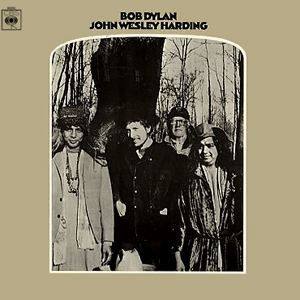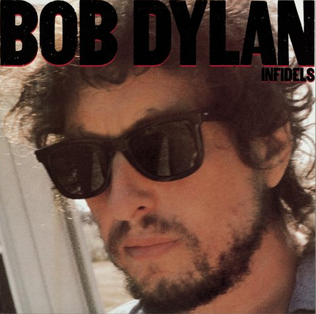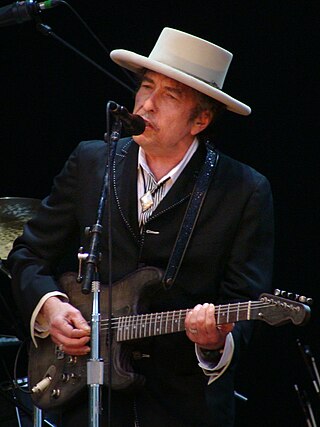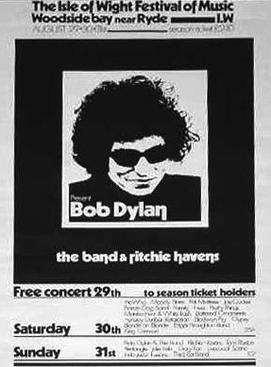Related Research Articles
Saint Augustine or Augustine of Hippo (354–430) was a bishop, theologian and father of the Latin Catholic Church.
Wesley Stace is an English folk/pop singer-songwriter and author who has used the stage name John Wesley Harding. Under his legal name, he has written four novels. He is also an occasional university teacher and the curator of Wesley Stace's Cabinet of Wonders.

"All Along the Watchtower" is a song by American singer-songwriter Bob Dylan from his eighth studio album, John Wesley Harding (1967). The song was written by Dylan and produced by Bob Johnston. The song's lyrics, which in its original version contain twelve lines, feature a conversation between a joker and a thief. The song has been subject to various interpretations; some reviewers have noted that it echoes lines in the Book of Isaiah, Chapter 21, verses 5–9. Dylan has released several different live performances, and versions of the song are included on some of his subsequent greatest hits compilations.

John Wesley Harding is the eighth studio album by American singer-songwriter Bob Dylan, released on December 27, 1967, by Columbia Records. Produced by Bob Johnston, the album marked Dylan's return to semi-acoustic instrumentation and folk-influenced songwriting after three albums of lyrically abstract, blues-indebted rock music. John Wesley Harding was recorded around the same time as the home recording sessions with The Band known as The Basement Tapes.

Infidels is the twenty-second studio album by American singer-songwriter Bob Dylan, released on October 27, 1983, by Columbia Records.

"Like a Rolling Stone" is a song by American singer-songwriter Bob Dylan, released on July 20, 1965, by Columbia Records. Its confrontational lyrics originated in an extended piece of verse Dylan wrote in June 1965, when he returned exhausted from a grueling tour of England. Dylan distilled this draft into four verses and a chorus. "Like a Rolling Stone" was recorded a few weeks later as part of the sessions for the forthcoming album Highway 61 Revisited.

Self Portrait is the tenth studio album by American singer-songwriter Bob Dylan, released on June 8, 1970, by Columbia Records.

Bob Dylan is an American singer-songwriter. Generally regarded as one of the greatest songwriters ever, Dylan has been a major figure in popular culture over his 60-year career. Much of his most celebrated work dates from the 1960s, when songs such as "Blowin' in the Wind" (1963) and "The Times They Are a-Changin'" (1964) became anthems for the civil rights and antiwar movements. His lyrics during this period incorporated political, social, philosophical, and literary influences, defying pop music conventions and appealing to the burgeoning counterculture.

The 1969 Isle of Wight Festival was held on 29–31 August 1969 at Wootton Creek, on the Isle of Wight. The festival attracted an audience of approximately 150,000 to see acts including Bob Dylan, the Band, the Who, Free, Joe Cocker, the Bonzo Dog Band and the Moody Blues. It was the second of three music festivals held on the island between 1968 and 1970. Organised by Rikki Farr, Ronnie and Ray Foulk's Fiery Creations, it became a legendary event, largely owing to the participation of Dylan, who had spent the previous three years in semi-retirement. The event was well managed, in comparison to the recent Woodstock Festival, and trouble-free.

The soundtrack album for the Bob Dylan biopic I'm Not There was released as a double CD on October 30, 2007. It features only one recording by Dylan himself—his previously unreleased recording of the title song "I'm Not There" recorded during The Basement Tapes' sessions in 1967—plus various other artists' recordings of songs written by Dylan. These CDs do not contain the movie sound track. Fragments from less than half of the titles are heard in the film, which features more of Dylan's own recordings. The end credits relay a complete list of music heard in the film.
"The Wicked Messenger" is a song written and originally performed by Bob Dylan for his album John Wesley Harding. The song was recorded at Columbia's Studio A, Nashville, on November 29, 1967.

Gotta Serve Somebody: The Gospel Songs of Bob Dylan is a tribute album independently produced by Jeffrey Gaskill of Burning Rose Productions, Ltd. and released under license on the Sony/Columbia label in 2003. The compilation features traditional and contemporary gospel singers performing songs written by Bob Dylan during his "born again" period (1979–81).
"I Am a Lonesome Hobo" is a song written and recorded by Bob Dylan, released in 1967 on his eighth studio album, John Wesley Harding. The song was produced by Bob Johnston.

"Most of the Time" is a song written and performed by American singer-songwriter Bob Dylan, released as the sixth track of his 1989 album Oh Mercy. The song was written by Dylan and produced by Daniel Lanois. The album version of "Most of the Time" was recorded on March 12, 1989, in a mobile studio at 1305 Soniat St., New Orleans, and released on Oh Mercy in September of that year. Two studio out-takes from the same set of recording sessions were released on The Bootleg Series Vol. 8: Tell Tale Signs: Rare and Unreleased 1989–2006 in 2008, and a new version recorded on March 16, 1990, was issued as a promotional single and video in 1990.

"Drifter's Escape" is a song written by Bob Dylan that he recorded for his 1967 album John Wesley Harding. Columbia Records released it as a single in the US and the UK in 1969 as the B-side to "I Threw It All Away". The song was recorded in four takes on October 17, 1967. CBS Records International also issued the song paired with "John Wesley Harding" in some markets.

The Original Mono Recordings is a box set compilation album of recordings by Bob Dylan, released in October 2010 on Legacy Recordings, catalogue 88697761042. It consists of Dylan's first eight studio albums in mono on nine compact discs, the album Blonde on Blonde being issued on two discs in its original vinyl format. It does not include the singles collection Bob Dylan's Greatest Hits released during the same time span. The set includes a 56-page booklet with photographs, discographical information, and an essay by Greil Marcus. It peaked at No. 152 on the Billboard 200.
"John Wesley Harding" is a song by American singer-songwriter Bob Dylan that appears as the opening track on his 1967 album of the same name.
"Mama, You Been on My Mind" is a song by American singer-songwriter Bob Dylan. Written in 1964 during a trip to Europe, the song dealt with his recent breakup with his girlfriend, Suze Rotolo. Dylan first recorded the song in June of that year during a session for his album Another Side of Bob Dylan. However, the song was not included on the album, and Dylan's version remained unreleased until 1991. In total, in the 1990s and 2000s four versions were put out on Dylan's Bootleg Series of releases, including two live performances with Joan Baez from 1964 and 1975.
"I Pity the Poor Immigrant" is a song by American singer-songwriter Bob Dylan. It was recorded on November 6, 1967, at Columbia Recording Studios, Nashville, produced by Bob Johnston. The song was released on Dylan's eighth studio album John Wesley Harding on December 27, 1967.
"Dear Landlord" is a song by American singer-songwriter Bob Dylan. It was recorded on November 29, 1967, at Columbia Recording Studios, Nashville, produced by Bob Johnston. The song was released on Dylan's album John Wesley Harding on December 27, 1967. It is a piano blues that has been interpreted as an address to his then-manager Albert Grossman.
References
- 1 2 3 4 5 6 7 Heylin, C. (2009). Revolution in the Air: The Songs of Bob Dylan 1957-1973. pp. 362–364. ISBN 978-1-55652-843-9.
- ↑ "I Dreamed I Saw St. Augustine covers". allmusic . Archived from the original on June 27, 2009. Retrieved 2009-06-25.
- ↑ Shapiro, H.; Glebbeek, C. (1995). Jimi Hendrix, Electric Gypsy . Macmillan. p. 320. ISBN 978-0-312-13062-6.
i dreamed i saw st. augustine hendrix.
- 1 2 3 4 5 6 "I Dreamed I Saw St. Augustine". allmusic . Retrieved 2009-07-10.
- ↑ Damsker, M. (1980). Rock Voices. pp. 11–13. ISBN 0-312-68790-7.
- 1 2 3 4 5 6 7 8 9 Gill, A. (1998). Don't Think Twice It's Alright. pp. 129–130. ISBN 1-56025-185-9.
- 1 2 3 4 Hinchey, J. (2002). Like a Complete Unknown. pp. 235–237. ISBN 0-9723592-0-6.
- ↑ Mellers, W. (1984). A Darker Shade of Pale . pp. 153–154. ISBN 0-19-503622-0.
- ↑ "The 100 Greatest Bob Dylan Songs". Mojo . September 2005. Retrieved 2009-07-10.